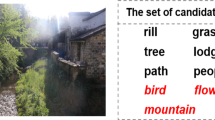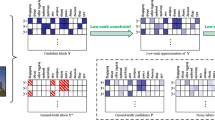Abstract
In Partial Label Learning (PLL), each training instance is assigned with several candidate labels, among which only one label is the ground-truth. Existing PLL methods mainly focus on identifying the unique ground-truth label, while the contribution of other candidate labels as well as the latent noisy side information are regrettably ignored. To tackle the above issues, we propose a novel PLL approach named PL-NSI, which simultaneously takes the feature noise and the contributions of other candidate labels into consideration. Specifically, given PLL data with noisy side information, we first leverage the latent label distribution to emphasize the different contributions of other candidate labels. Then, we utilize the low-rank representation to recover the ideal feature space from the corrupted observations. In addition, to improve the robustness of the final model, we adopt an extra regularization term to exploit the consistency between visual information and semantic information. Finally, we conduct enormous experiments on both artificial and real-world data sets, and the experimental results verify that our method can achieve competitive performance against state-of-the-art methods.






Similar content being viewed by others
References
Briggs F, Fern X, Raich R (2012) Rank-loss support instance machines for miml instance annotation. In: ACM SIGKDD international conference on knowledge discovery and data mining, pp 534–542
Candès E, Plan Y (2010) Matrix completion with noise. Proceedings of the IEEE 98(6):925–936
Candès E, Li X, Ma Y, Wright J (2009) Robust principal component analysis? In: Journal of the ACM
Chen C, Patel V, Chellappa R (2015) Matrix completion for resolving label ambiguity. In: Proceedings of the 2015 IEEE conference on computer vision and pattern recognition, pp 4110–4118
Chen G, Liu T, Tang Y, Jian Y, Jie Y, Tao D (2017) A regularization approach for instance-based superset label learning. IEEE Transactions on Cybernetics 48(3):967–978
Chen Y, Patel V, Chellappa R, Phillips P (2014) Ambiguously labeled learning using dictionaries. IEEE Transactions on Information Forensics and Security 9(12):2076–2088
Cour T, Sapp B, Taskar B (2011) Learning from partial labels. IEEE Transactions on Knowledge and Data Engineering 12(5):1501–1536
Feng L, An B (2018) Leveraging latent label distributions for partial label learning. In: International joint conference on artificial intelligence, pp 2107–2113
Feng L, An B (2019a) Partial label learning by semantic difference maximization. In: International joint conference on artificial intelligence, pp 2294–2300
Feng L, An B (2019b) Partial label learning with self-guided retraining. In: Proceedings of the AAAI conference on artificial intelligence, pp 3542–3549
Guillaumin M, Verbeek J, Schmid C (2010) Multiple instance metric learning from automatically labeled bags of faces. In: European conference on computer vision, pp 634–647
He S, Li L (2018) Estimating latent relative labeling importances for multi-label learning. In: Proceedings of the IEEE international conference on data mining, pp 1013–1018
Hullermeier E, Beringer J (2005) Learning from ambiguously labeled examples. International Symposium on Intelligent Data Analysis 10(5):168–179
Luo J, Orabona F (2010) Learning from candidate labeling sets. In: Advances in neural information processing systems, pp 1504–1512
Lv J, Xu M, Feng L, Niu G, Geng X, Sugiyama M (2020) Progressive identification of true labels for partial-label learning. In: Proceedings of the international conference on machine learning, pp 6500–6510
Lyu G, Feng S, Huang W, Dai G, Zhang H, Chen B (2020) Partial label learning via low-rank representation and label propagation. Soft Comput 24(7):5165–5176
Lyu G, Feng S, Li Y, Jin Y, Dai G, Lang C (2020) Hera: Partial label learning by combining heterogeneous loss with sparse and low-rank regularization. ACM Transactions on Intelligent Systems and Technology 11(3):1–19
Lyu G, Feng S, Li Y, Jin Y, Dai G, Lang C (2020) HERA: partial label learning by combining heterogeneous loss with sparse and low-rank regularization. ACM Transactions on Intelligent Systems and Technology 11(3):1–19
Lyu G, Feng S, Wang T, Lang C (2020d) A self-paced regularization framework for partial-label learning. IEEE Transactions on Cybernetics:1–13. https://doi.org/10.1109/TCYB.2020.2990908
Lyu G, Feng S, Wang T, Lang C, Li Y (2021) Gm-pll: Graph matching based partial label learning. IEEE Transactions on Knowledge and Data Engineering 33(2):521–535
Nguyen N, Caruana R (2008) Classification with partial labels. In: ACM SIGKDD International conference on knowledge discovery and data mining, pp 551–559
Panis G, Lanitis A (2016) An overview of research activities in facial age estimation using the fg-net aging database. Journal of American History 5(2):37–46
Wang C, Yan S, Zhang L (2009) Multi-label sparse coding for automatic image annotation. In: IEEE Conference on computer vision and pattern recognition, pp 20–25
Wang D, Zhang M (2019) Adaptive graph guided disambiguation for partial label learning. In: Proceedings of the ACM SIGKDD international conference on knowledge discovery and data mining, pp 83–91
Wang J, Zhang ML (2018) Towards mitigating the class-imbalance problem for partial label learning. In: ACM SIGKDD international conference on knowledge discovery and data mining, pp 2427–2436
Wang Q, Zhou Z (2019) Partial label learning with unlabeled data. In: Proceedings of the international joint conference on artificial intelligence, pp 3755–3761
Wu X, Zhang ML (2018) Towards enabling binary decomposition for partial label learning. In: International joint conference on artificial intelligence, pp 2868–2874
Xie M, Huang S (2020) Semi-supervised partial multi-label learning. In: IEEE International conference on data mining, pp 691–700
Yu F, Zhang M (2017) Maximum margin partial label learning. Machine Learning 106(4):573–593
Yu F, Zhang ML (2016) Maximum margin partial label learning. In: Asian conference on machine learning, pp 96–111
Yu G, RangWala H, Domeniconi C, Zhang G (2013) Protein function prediction using dependence maximization. In: IEEE Conference on computer vision and pattern recognition, pp 574–589
Zeng Z, Xiao S, Jia K, Chan T, Gao S, Xu D, Ma Y (2013) Learning by associating ambiguously labeled images. In: IEEE Conference on computer vision and pattern recognition, pp 708–715
Zhang M, Yu F (2015) Solving the partial label learning problem: an instance-based approach. In: International joint conference on artificial intelligence, pp 4048–4054
Zhang M, Yu F, Tang C (2017) Disambiguation-free partial label learning. IEEE Transactions on Knowledge and Data Engineering 29(10):2155–2167
Zhang ML (2014) Disambiguation-free partial label learning. In: Proceedings of the 2014 SIAM international conference on data mining, pp 37–45
Zhou Y, He J, Gu H (2016) Partial label learning via gaussian processes. IEEE Transactions on Cybernetics 47(12):4443–4450
Zhu G, Yan S, Ma Y (2010) Image tag refinement towards low-rank, content-tag prior and error sparsity. In: Proceedings of the ACM international conference on multimedia, pp 461–470
Author information
Authors and Affiliations
Corresponding author
Additional information
Publisher's note
Springer Nature remains neutral with regard to jurisdictional claims in published maps and institutional affiliations.
Shaokai Wang and Mingxuan Xia contributed equally to this work.
Rights and permissions
About this article
Cite this article
Wang, S., Xia, M., Wang, Z. et al. Partial label learning with noisy side information. Appl Intell 52, 12382–12396 (2022). https://doi.org/10.1007/s10489-021-03137-0
Accepted:
Published:
Issue Date:
DOI: https://doi.org/10.1007/s10489-021-03137-0




